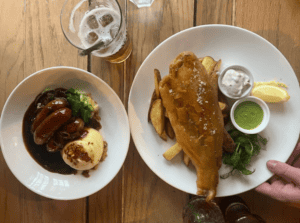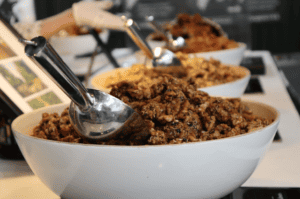On our London food tours, we frequently encounter flavors and dishes steeped in the city’s history, particularly those from the World War II era. Our local expert guides tell amazing stories, but we thought the profound impact of WW2 Food on contemporary English gastronomy deserved a full article. The challenges and innovations of that era have left a lasting imprint on England’s culinary culture, shaping it in enduring ways.
During the war, food was a symbol of resilience and resourcefulness in the face of adversity. The rationing system, while restrictive, led to a wave of culinary creativity that has influenced English cooking to this day. From humble root vegetables to hearty stews, the legacy of wartime cuisine is a testament to the enduring spirit of a nation.
Wartime Rations and Their Influence
The rationing, which began in January 1940, was a response to the national shortage of food and included a range of basic foodstuffs like sugar, meat, fats, bacon, and cheese. These items were rationed using a system of coupons and points, which changed according to availability and consumer demand. The Ministry of Food, responsible for overseeing rationing, ensured fair distribution of these limited resources. Every individual, including children and expectant mothers, received a ration book to purchase rationed goods.
This rationing system led to a cultural shift in food consumption and preparation. Housewives and cooks became adept at using rationed items creatively, often relying on vegetables grown in home gardens and allotments, part of the ‘Dig For Victory’ campaign. This period saw an emphasis on resourcefulness and innovation in cooking, with a focus on using limited ingredients effectively.
Interestingly, not all foods were rationed. Items like fruit and vegetables were never on the ration but were often scarce. The government’s push for self-sufficiency in growing vegetables played a significant role in shaping the ‘Dig For Victory’ effort, where public parks and private gardens were turned into vegetable plots.
Post-war, rationing continued for several years, with the last items being de-rationed in the early 1950s. This extended period of rationing fundamentally altered the British approach to food and cooking, laying the groundwork for the modern gastronomy scene in England.
The legacy of rationing is visible in contemporary English cuisine, which often reflects the simplicity, waste reduction, and emphasis on local produce that were hallmarks of the wartime cooking ethos.

Post-War Evolution of English Cuisine
In the transformative years following World War II, England experienced profound changes in its gastronomy, shaped by societal shifts and technological advancements. The end of rationing in 1954 marked the beginning of a new era characterized by culinary exploration and diversity. As living standards and disposable incomes rose, people eagerly tried new foods and frequented restaurants, embracing flavors from different parts of the world. This period was a departure from the war years’ emphasis on simplicity and resourcefulness in food, signaling a newfound excitement about culinary experiences.
Technological innovations also played a crucial role in reshaping English cuisine. The emergence of modern, all-electric kitchens equipped with electric ranges, refrigerators, and various appliances revolutionized food preparation. Processed and canned foods, seen as symbols of modernity, became increasingly popular, reflecting a significant change in dietary habits and cooking methods. This was a time when convenience in the kitchen became a priority, aligning with the broader cultural shift towards a more modern lifestyle.
The post-war years also saw a dramatic expansion of supermarkets, changing the way people shopped and ate. These supermarkets, part of the larger trend of suburbanization, offered a wider variety of food, including processed items, catering to the growing demand for convenience. The transformation of the kitchen into a domain with modern appliances and an emphasis on time-saving methods reflected the changing roles and expectations of women in society. This period marked a significant shift in English gastronomy, laying the foundations for the diverse and vibrant culinary scene seen in England today.
Modern English Gastronomy: Echoes of the Past
The post-WW2 era marked the beginning of a transition from traditional, hearty English fare to a more varied and cosmopolitan cuisine. The gradual reintroduction of previously rationed items, combined with the influence of foreign cuisines brought about by global interactions, played a significant role in reshaping the English palate.
The influence of international cuisines, particularly from Commonwealth countries and former colonies, has been significant. Dishes from India, for instance, have been integrated and adapted to suit British tastes. Classic examples include chicken tikka masala and coronation chicken, both of which have their origins in Indian cuisine but have been modified to appeal to the British palate.
Traditional British dishes, too, have evolved. While classics like the full English breakfast, roast dinners, and fish and chips remain staples, there’s been a noticeable shift towards incorporating a wider range of ingredients and flavors. This is evident in the popularity of dishes that were once considered exotic, such as balti dishes from the Indian subcontinent and various Anglo-Indian fusion dishes.
The transformation of British pubs post-WW2 is another significant aspect of this culinary evolution. Pubs, once simple drinking establishments, have become integral to community life and gastronomy, often serving as local eateries offering a variety of traditional and contemporary dishes.

The Legacy of Rationing in Contemporary Cooking
The period of constrained resources led to the development of dishes such as Lord Woolton Pie, Vinegar Cake, and Spam Hash, which have left a lasting imprint on English cuisine. These dishes were born out of necessity but continued to influence British cooking long after the war. The Ministry of Food played a crucial role in guiding the public through these challenging times, offering recipe books, nutritional advice, and cooking leaflets to help people make the most of their rations. This era saw the British population gaining a deeper understanding of nutrition and cooking practices.
After the war, the gradual reintroduction of various foods, along with the influence of foreign cuisines due to increased global interactions, began to shape the post-war evolution of English cuisine. Immigration and global trade post-WWII introduced new flavors and ingredients, leading to a diversification of the culinary landscape in England. This period marked the beginning of a more varied and rich culinary culture, which blended traditional English cooking with new influences from around the world.
The legacy of wartime rationing can still be seen in contemporary English cooking, where there remains an emphasis on local produce, waste reduction, and simplicity in cooking. These practices, rooted in the wartime necessity of making do with limited resources, have evolved into a modern appreciation for sustainable and efficient cooking methods.

The Global Influence on English Food Post-WWII
Post-World War II, England’s culinary scene underwent a significant transformation, largely due to the influence of global interactions and immigration. This era introduced a variety of new flavors and techniques to English cuisine, as people from Commonwealth countries and former British colonies brought their culinary traditions with them. Indian and Caribbean cuisines, for example, introduced new spices and vibrant flavors, leading to the creation of fusion dishes like chicken tikka masala.
This period also saw the rise of international travel, which further expanded the culinary horizons of the English. Exposure to European cuisines, especially from France and Italy, influenced English cooking not just in terms of dishes but also in cooking techniques and ingredients. This led to a subtle evolution of traditional English recipes, incorporating foreign elements while maintaining their essence.
The post-WWII globalization of English cuisine represents a key chapter in the nation’s gastronomic history. It demonstrates how embracing different cultures and flavors can enrich a culinary tradition, blending the old with the new to create a culinary landscape that is both unique and reflective of the nation’s historical journey.
We invite you to embark on one of our London food tours. Where you’d be able to taste firsthand the reflections of WW2 Food in contemporary English gastronomy. From classic wartime recipes to modern fusion dishes, our tours offer a unique opportunity to explore the culinary journey England has undergone since WWII. Whether you’re a history buff, a food enthusiast, or simply curious about the evolution of English cuisine, our tours promise an enriching and delicious experience.
